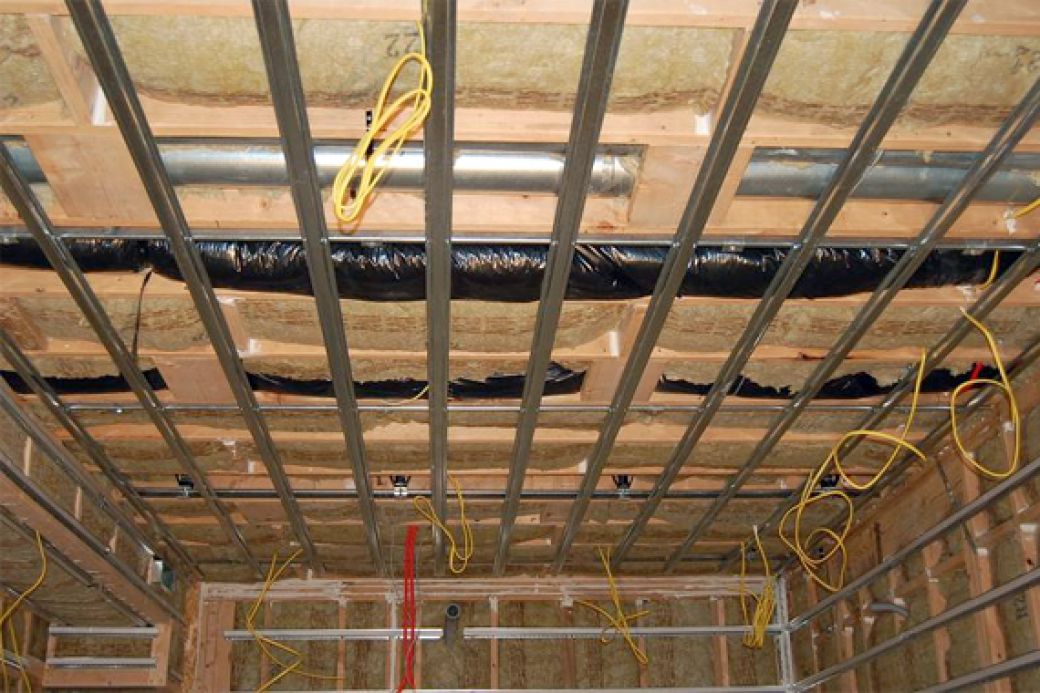Overhead noise can be harsh -- footfalls, stomps, dropped objects -- or ambient sound, such as TVs and stereos. To conquer unwanted sounds, you’ll need to soundproof either your ceiling, your floors, or both. If you want full soundproofing, you’ll have to soundproof walls, too.
Adding rugs and carpets, even upholstered furnishings, can help. But to truly conquer the problem, you’ll need to install materials that absorb or interrupt all sorts of noise.
Absorbing noise: A soft material such as fiberglass insulation may seem the best option, but what really does the job is a dense, heavy material such as drywall, medium density fiberboard (MDF), or a layer of heavy vinyl sheeting.
Interrupting sound: Creating a gap or inserting a non-conductive barrier prevents noise from vibrating through ceiling and floor joists. In effect, you’re adding a second, separate floor or ceiling.
Strategies for Soundproofing Floors
- Add heavy sheet goods: MDF plywood ($1 per sq. ft.) adds sound-absorbing mass. Sound-damping plywood ($1.90 per sq. ft.) includes an elastic layer to interrupt sound. Fasten with adhesive, not screws.
- Apply an acoustic barrier: Install 4-by-8-foot self-adhesive rolls of ½-inch-thick recycled rubber sheeting under hardwood, laminate, carpet, and ceramic tile. If you’re tiling, you can substitute rubber sheeting for cement backer board. Cost: $.40 to $1.50 per sq. ft.
- Install acoustic carpet underlayment: Soundproofing underlayment cuts impact and airborne noise and is made specifically for use under carpeting. Cost: $.55–$2.30 per sq. ft.
- Add mass loaded vinyl (MLV): Although expensive, ¼-inch MLV can block 90% of airborne noise ($2.50 per sq. ft.).
Strategies for Soundproofing Ceilings
- Add fiberglass insulation: Exposed joists in the basement offer the chance to install fiberglass bats ($.65 per sq. ft.). While you’re at it, add a layer of drywall ($.22 per sq. ft.).
- Install acoustic tiles: The commercial look is an acquired taste, but acoustic tiles can suit a home office or study. The panels, held by a metal grid, are made of fiberglass, sometimes with sound-interrupting foil or MLV layer. Cost: About $8 per sq. ft.
- Add a second layer of drywall: Acoustic drywall ($45 per 4-by-8-ft. sheet) has two layers of gypsum separated by a soft polymer. It can cut perceived sound by half.
- Add mass-loaded vinyl sheeting, then drywall: Mass-loaded vinyl (MLV) absorbs and interrupts sound. A 4-by-30-ft. roll costs $140–$230. Drywall costs $.22 per sq. ft.
- Attach drywall on isolation clips: By fastening these clips to your ceiling joists, you can install a channel to support a second layer of drywall -- a second skin for your ceiling. A rubber bushing built into the clip halts sound vibration. Clips are about $5 each; a 10-foot channel is $3.50.
Is Soundproofing Ceilings and Floors Worth the Investment?
Soundproofing is not likely to boost the resale value of your home, according to David Maturen, an appraiser in Portage, Mich. There are simply too few comparisons to be had with conventional homes, he explains.
“We need more resales of homes with super soundproofing,” says Maturen.
That may be changing, however, as home owners become more conscious of sound reduction possibilities in their homes.
“Sound is the new mold,” jokes Josh Kernan, general manager of Westside Drywall in Hubbard, Ore., a specialist in soundproofing. “We’re already seeing condo owners creating lawsuits because of noise problems.”
Related:
